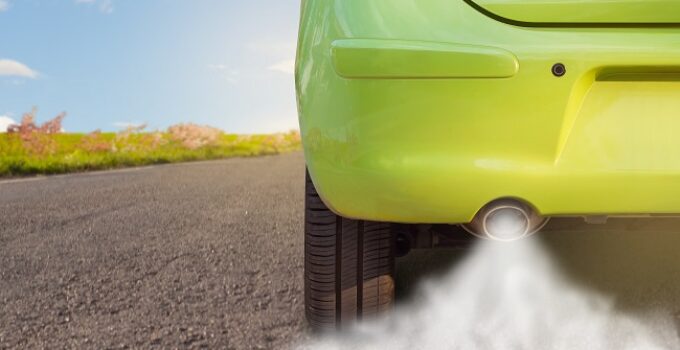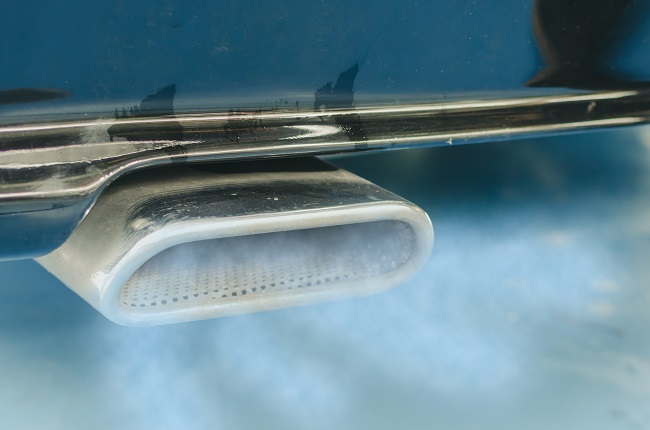
One of the many signs of a defective engine and related systems is smoke from the exhaust. Many problems can be diagnosed by its color and texture. In this article we explain what colors exhaust smoke could be and why it looks like.
Contents
Why does my car smoke when I start it?
If smoke comes from the engine only when you start it, especially in freezing cold or dry weather, and it goes away once the engine has warmed up, this does not indicate a defect: this is how condensate from the exhaust system evaporates.
Why is there white smoke coming out of the exhaust?
If smoke from the exhaust does not go away after the engine warms up, and this happens in dry and hot weather, this indicates water ingress into the engine. This usually happens in two ways: either when it is mixed with the coolant, which indicates a leak in the cylinder head gasket or cooling system, or with the fuel, if the fuel is of poor quality.
How to get rid of white smoke from the exhaust? Follow these steps:
- Check the coolant level in the reservoir. A sharp drop indicates a loss of tightness in the cooling system.
- Check the engine compartment: Leaks can often be found at the junction between the engine block and the cylinder head.
- Look inside the coolant reservoir. The presence of oil is an indirect indication of a loss of head gasket integrity and, along with white smoke, is an indication that coolant is entering the engine's combustion chambers.
- Check the oil filler neck. There should be no white foam inside.
- If at least one of the above signs is detected, take your car to a workshop to have it professionally checked. The repair inevitably leads to the replacement of the cylinder head gasket and the joint surface of the engine block and cylinder head may also need to be ground.
- If there are no defects in the cooling system, try another gas station.
- Check that the fuel tank is leaking. Have it repaired or replaced as needed.

If white smoke comes from my car, can I continue driving it?
No you can't. Never delay troubleshooting: coolant dilutes oil when mixed with it, affecting the latter's lubricating properties. This can wear out moving parts of the engine. Therefore, you should also use a tow truck to reach a workshop.
Sometimes white smoke comes out from under the hood. This can be a sign of boiling coolant and an overheated engine, as well as a loss of tightness in the radiator or its pipes. In this case, stop the car immediately and let the engine cool down. Then check the cooling system for leaks. Should a serious leak be discovered, further driving is strictly forbidden.
Why is my car getting black smoke?
Thick, black smoke from the exhaust is a sign of an over-rich fuel-air mixture. This can be caused by a clogged air filter causing less air to get to the engine, or a defective fuel pump or regulator resulting in increased pressure in the fuel line.
If you notice a problem, follow these steps:
- Measure the pressure in the fuel system with a manometer.
- Check the injectors. To do this, use a multimeter to measure its resistance and compare the values obtained with the nominal values.
- Make sure the lambda sensors are working properly. First, check that the sensors are firmly seated in the connectors. If necessary, clean the connections. Disassemble and inspect the part. The presence of deposits on the component's protective cylinder indicates that it needs to be replaced.
- Start the ignition. Connect the test leads of the multimeter to the circuit of the radiator. The voltage should be 12V.
- Connect the test probes to the signal cable and chassis ground. The multimeter should show 0.45 V.
- Disconnect the device. Measure the resistance between the radiator terminals. Measurements may vary depending on sensor type, but should not exceed 2-10 ohms.
- Insert a new sensor in place of the defective one.
- If you have a diesel vehicle, start it Particulate filter regeneration mode.
- In diesel vehicles, thick black smoke can be caused by a clogged particulate filter.

If black smoke comes from my car, can I continue driving it?
If black smoke is coming out of your car, you should determine the problem as soon as possible. In fact, an over-rich fuel-air mixture burns more slowly than usual, which leads to local overheating of parts of the engine. In addition, a component of the fuel burns in the exhaust, causing a risk of engine knocking and catalyst destruction. Spark plugs fail earlier than usual. Over time, parts of the exhaust system can burn out. Sometimes the engine seizes up.
Why is there blue smoke coming out of the exhaust?
If blue smoke comes out of the exhaust, this indicates that oil has entered the combustion chambers. This is most often caused by the wear of parts of the piston-cylinder system, piston ring sticking, valve stem seal wear and the use of incorrect viscosity oil.
Here is what you need to do:
- Make sure the correct oil is used in your lubrication system. If not, replace it along with a thorough flush.
- Measure the compression in the engine cylinders. If this is insufficient, the density of the combustion chambers will be lost. A more thorough diagnosis is needed.
- Take your car to a workshop: Often the blue smoke from the car is a sign that the engine needs an overhaul. This is impossible to do without expert help.

What happens if I continue driving my car when blue smoke is coming from the engine?
Blue smoke alone is an indication of existing defects. However, if you postpone solving the problem, the situation will only get worse. For example, by replacing the valve stem seals and piston rings in a timely manner, you can avoid major problems. However, if you delay the change, the pistons can burn out, resulting in much higher costs.
Conclusion
Smoke from the exhaust almost always indicates defects in various systems of the vehicle. You cannot ignore these signs. The sooner you find it when troubleshooting, the less damage you will cause to your car.
